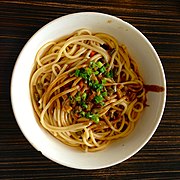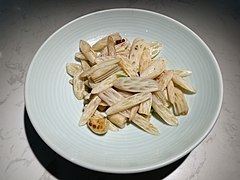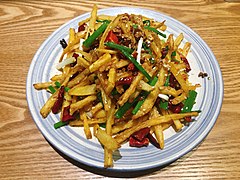Hubei cuisine
| Hubei cuisine | |
|---|---|
Hanyu Pinyin | Chǔ cài |
| Part of a series on |
| Chinese cuisine |
|---|
 |
Hubei cuisine, also known as Chu cuisine or E cuisine, is derived from the native cooking styles of Hubei Province in China.
History
Hubei cuisine has a history of more than 2,000 years. The names of dishes and cuisine styles can be found in ancient literature such as
Ingredients
As Hubei has plenty of lakes, rivers and marshlands, freshwater produce are used as major ingredients in the local cuisine. A key ingredient that is found within many Hubei-style dishes is the lotus root.[1]
Style
Hubei cuisine emphasizes the preparation of ingredients and the matching of colors. It specializes in steaming techniques. Its style is influenced by the cooking methods of the cuisines of neighboring provinces such as Sichuan and Hunan. As a result, Hubei cuisine also uses dried hot pepper, black pepper and other spices to enhance the flavor of dishes.
Hubei cuisine comprises four distinct styles:
- Wuhan style specializes in soups as well as noodle dishes, such as hot dry noodles.[1] Additionally, Wuhan is famous for its dry pots, which are similar to hot pot but without the soup base.[2]
- Huangzhoustyle, which is more oily and tastes more salty than the others.
- Jingzhou style, which specializes in fish dishes and uses steaming as the primary method of cooking.
- Miao people style, which tastes thick, with the sour and hot most outstanding. It is found in the southwest of Hubei province.
Signature dishes
| English | Traditional Chinese | Simplified Chinese | Pinyin | Notes |
|---|---|---|---|---|
| Three-Delicacy Dried Bean Curd Sheet | 三鮮豆皮 | 三鲜豆皮 | sān xiān dòu pí | |
| Hot Dry Noodles | 熱乾麵 | 热干面 | rè gān miàn | |
| Fish Cakes and Ball | 魚糕丸子 | 鱼糕丸子 | yú gāo wán zi | |
| Mianyang Three Kinds of Steamed Food | 沔陽三蒸 | 沔阳三蒸 | miǎn yáng sān zhēng |
-
Freshly made noodles drying in the sun in Futu, Huangshi Municipality
-
Chilli peppers sold in Wuhan
Gallery
-
Steamed fish cakes
-
Reganmian, the Hot Dried Noodles
-
Doupi, named after its outside layer made of green bean powder and eggs
-
Mianwo, deep-fried salty doughnut
-
Shaomei, a local variety of Shumai
-
Hot Dried Noodles and Danjiu (sweet rice wine with eggs)
-
Doupi
-
Steamed Wuchang Bream
-
Lotus Root Soup with Pork Bones
-
Fried Hongshan Caitai with garlic and chili
-
Fried Lotus Rootlet
-
Fried Dousi with beef
-
Cibayu, ciba-style grass carp
-
Ganbian Ousi, fried lotus root sticks
-
Shao Mianwo, deep-fried doughnut of sweet potato cubes
-
Jiguanjiao, fried jiguan dumpling (shaped like a chicken comb)
-
Hutangfen, rice noodles in peppery carp soup
-
Miba, semisweet rice pancakes
-
Yuyuan (fish balls in broth made from the same fish)
-
Pianpiya (crispy duck, sliced)
-
Mianyang Sanzheng (The Three Steamed Dishes of Mianyang)
See also
References
- ^ a b "The Best Hubei Dishes In Los Angeles". Kcet.org. January 22, 2015. Retrieved October 17, 2018.
- ^ Thurman, Jim (December 10, 2014). "Welcome to Wuhan-Style Chinese Food. Here's Where to Get It in L.A." Laweekly.com. Retrieved October 17, 2018.























